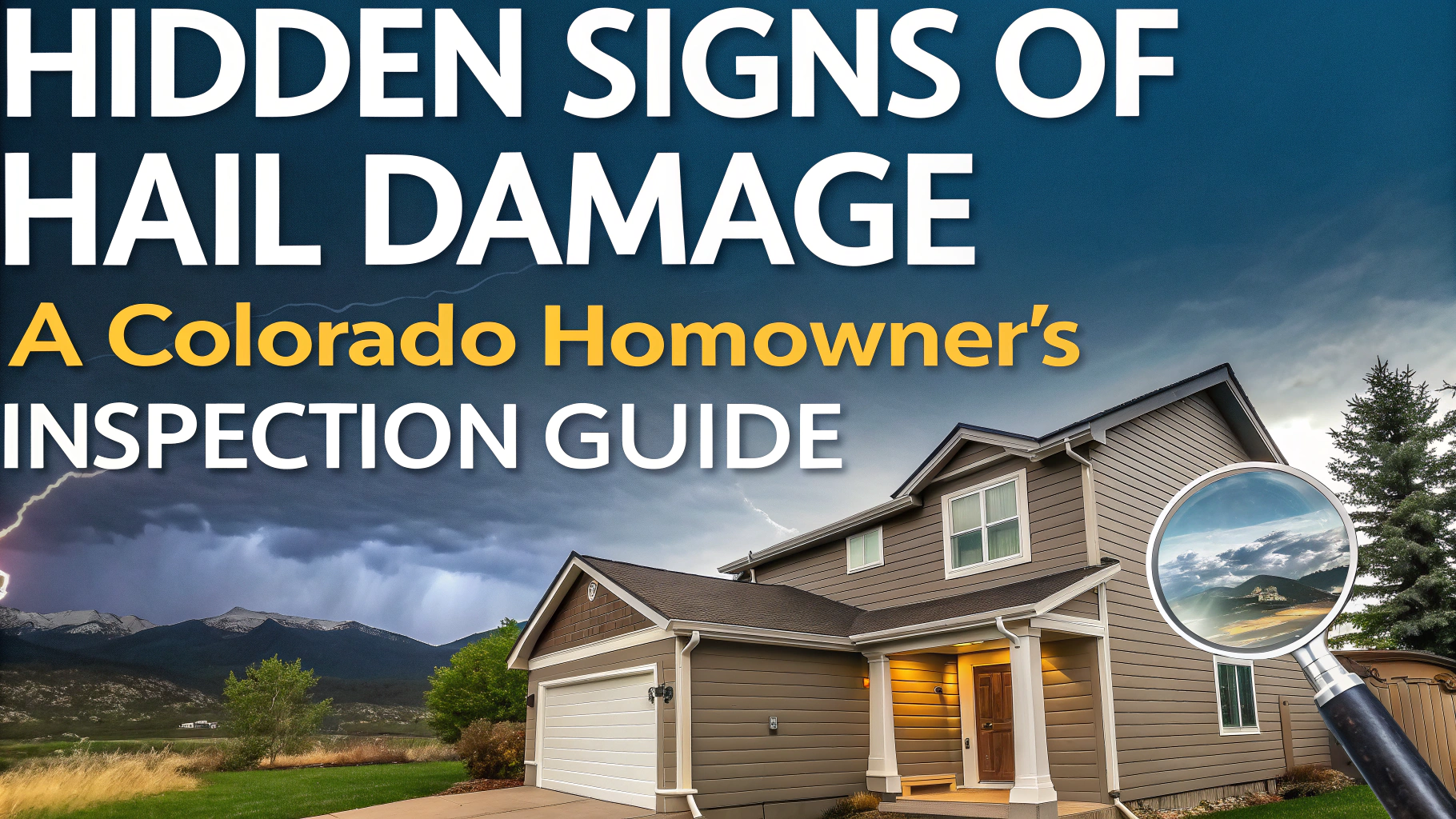Hail damage to your Colorado home isn’t always obvious at first glance, especially when it comes to your roof.
Living in Colorado means dealing with frequent hailstorms that can significantly impact your property’s structural integrity and value.
This guide helps homeowners spot subtle signs of hail damage that often go unnoticed during routine inspections.
Common Hidden Signs of Hail Damage
- Granule loss in gutters and downspouts
- Dark spots or “bruising” on shingles
- Dented or damaged flashing around vents
- Cracked or split shingles
- Small indentations that feel soft when pressed
Inspection Areas to Check
Start your inspection by examining the gutters and drainage systems for accumulated granules.
Look for circular patterns or spots on your shingles that appear darker than surrounding areas.
Check metal surfaces like vents, flashing, and air conditioning units for denting patterns.
Professional Assessment Tips
- Document damage with clear photos
- Mark damaged areas with chalk for insurance purposes
- Contact a licensed Colorado roofing inspector within 1-2 years of a major storm
- Request a detailed written report
When to Call an Expert
Contact a professional roofer immediately if you notice water stains on your ceiling or walls.
Schedule an inspection if your neighbors have received approval for hail damage claims.
| Damage Severity | Recommended Action |
|---|---|
| Minor (few spots) | Monitor and document |
| Moderate | Schedule inspection within 30 days |
| Severe | Immediate professional assessment |
Insurance Claim Guidelines
Document all damage with timestamped photos before any repairs begin.
Contact your insurance company within the state-mandated reporting period (typically 1 year in Colorado).
Keep all correspondence and inspection reports for your records.
Protecting Your Investment
- Schedule annual roof inspections in spring
- Keep trees trimmed away from your roof
- Clean gutters regularly to spot granule loss
- Consider impact-resistant roofing materials for future replacements
For professional roof inspections in Colorado, contact a licensed roofing contractor through the Colorado Roofing Association or call (303) 484-0549.
Preventive Measures
Taking proactive steps can minimize potential hail damage and extend your roof’s lifespan.
- Install protective mesh covers over skylights
- Apply roof coating treatments
- Maintain proper attic ventilation
- Remove debris after storms
Cost Considerations
Repair Estimates
| Repair Type | Average Cost Range |
|---|---|
| Shingle Replacement | $500-$1,500 |
| Flashing Repair | $200-$500 |
| Full Roof Replacement | $8,000-$20,000 |
Long-Term Roof Protection
Regular maintenance and swift action after hailstorms protect your home’s value and prevent costly repairs.
- Keep detailed maintenance records
- Build a relationship with a trusted roofing contractor
- Consider upgrading to Class 4 impact-resistant materials
- Review insurance coverage annually
Securing Your Home’s Future
Understanding and addressing hail damage early ensures your Colorado home remains protected through severe weather seasons.
Stay vigilant with regular inspections and maintain comprehensive documentation to protect your investment for years to come.
Remember that professional assessment is key to maintaining your roof’s integrity and your home’s value in Colorado’s challenging climate.
FAQs
1. What are the most common hidden signs of hail damage on a Colorado roof?
Granule loss on shingles, small dimples in metal vents or flashing, cracked or bruised shingles, dented gutters and downspouts, and circular impact marks that may only be visible up close.
2. How soon after a hailstorm should I inspect my roof?
Within 1-2 weeks of the hailstorm, but always wait until safe weather conditions. Document the date of the storm for insurance purposes.
3. Can hail damage lead to leaks even if I can’t see obvious holes?
Yes, hail impacts can crack the shingle’s underlayment or loosen its seal, causing slow leaks that may not be immediately noticeable but can cause significant damage over time.
4. What size hail typically causes damage to Colorado roofs?
Hail 1 inch (quarter-size) or larger typically causes damage, but even smaller hail can damage roofs when driven by high winds or if the roof is older.
5. How long do I have to file an insurance claim for hail damage in Colorado?
Most insurance companies in Colorado require claims to be filed within one year of the damage, but it’s best to file within 60 days of the hail event.
6. What makes Colorado roofs particularly vulnerable to hail damage?
Colorado’s high altitude, frequent severe storms, intense UV exposure, and extreme temperature fluctuations make roofing materials more susceptible to hail damage.
7. Are certain roofing materials more resistant to Colorado hail?
Impact-resistant Class 4 shingles, metal roofing, and concrete tiles offer better protection against hail damage than standard asphalt shingles.
8. How can I tell the difference between hail damage and normal wear and tear?
Hail damage typically shows random impact patterns with consistent size marks, while normal wear appears as uniform deterioration across the roof surface.
9. Should I hire a professional inspector or can I identify hail damage myself?
While homeowners can spot obvious damage, professional inspectors have training to identify subtle damage patterns and can safely access all roof areas.
10. Will my insurance rates increase if I file a hail damage claim in Colorado?
Typically, hail damage claims are considered “Act of God” events and don’t directly increase individual rates, but frequent area-wide claims may affect regional rates.
